ANNUAL OPEN LETTER TO THE PEOPLE OF PURDUE FROM MITCH DANIELS
January 2016
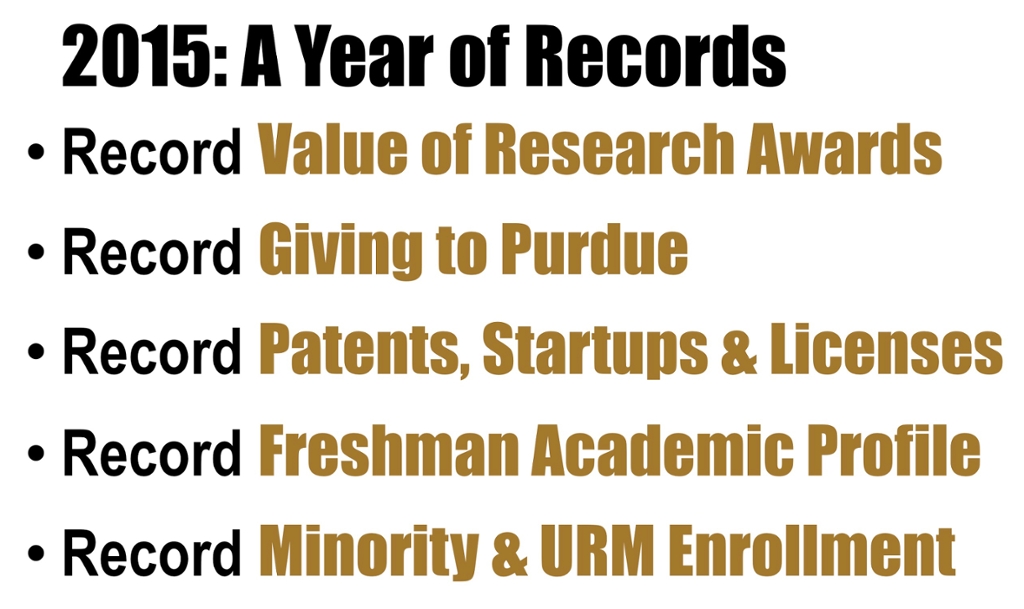 As I wish everyone a sincere Happy 2016, I could venture to hope for a year as generally successful as the one just passed. Our university saw record applications from an entering class that set another record for academic qualifications; record research grants; record numbers of patents, licenses, and startup companies; and record donations, all by substantial margins over the previous highs. But as our athletic coaches would remind us, we are only as good as our next game, so this letter, like its predecessors, will studiously face forward, addressing four broad topics that I hope are of interest to us all.
As I wish everyone a sincere Happy 2016, I could venture to hope for a year as generally successful as the one just passed. Our university saw record applications from an entering class that set another record for academic qualifications; record research grants; record numbers of patents, licenses, and startup companies; and record donations, all by substantial margins over the previous highs. But as our athletic coaches would remind us, we are only as good as our next game, so this letter, like its predecessors, will studiously face forward, addressing four broad topics that I hope are of interest to us all.
RESEARCH AT PURDUE
Both new records and new approaches to our research mission prompt me to begin with that topic. Our 2015 grants total of $401 million was especially encouraging in an environment of essentially flat federal funding and greater than ever competition for those funds. Purdue faculty from virtually every department contributed to this success.
But equally important is the 36% growth, from $98 million to $134 million, of sponsored research from non-government sources, such as corporations and foundations. While such grants have historically been a somewhat larger share of total Purdue research than at peer schools, the last couple years have seen a highly intentional and promising escalation in this area. A deeply indebted federal government, running massive deficits that are unavoidably destined to increase markedly in the next decades, will not be a reliable source of dollars for the research growth to which we aspire. Most of our peers now pay lip service to the expansion of non-traditional partnerships, but Purdue for now has a clear leadership position.
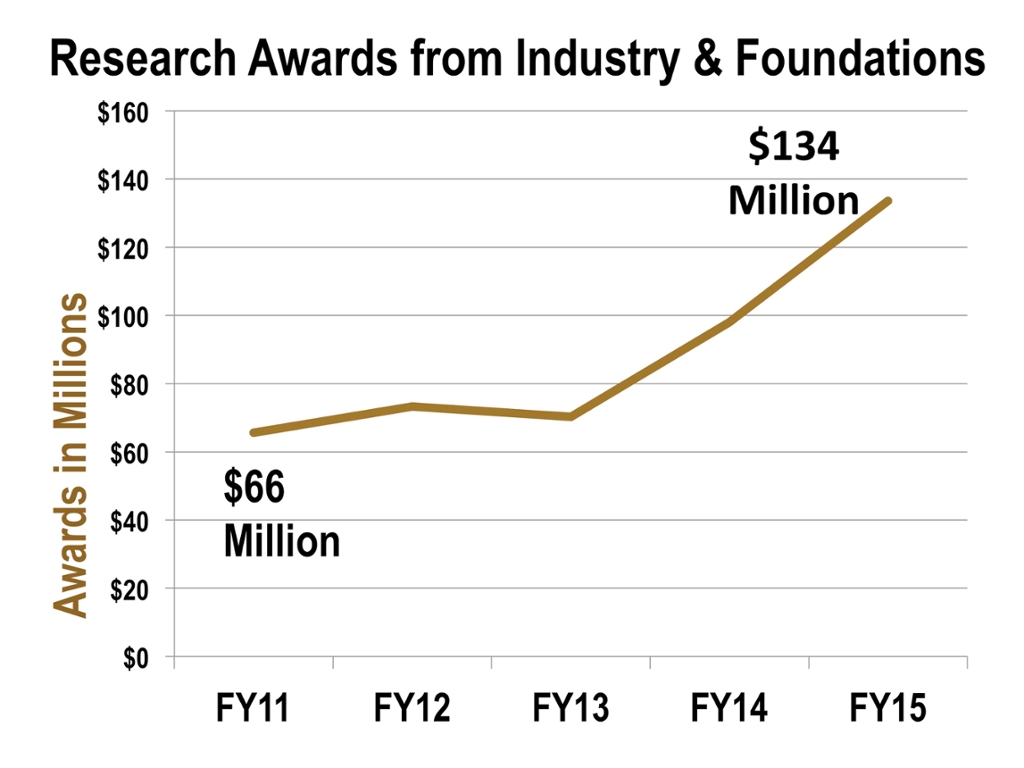 Primary credit for this advantage goes to Executive Vice President Suresh Garimella and Chief Corporate and Global Partnerships Officer Dan Hirleman, who have brought order and structure to our tremendous research capabilities. Partners like GE, Intel, Fiat-Chrysler, and Microsoft are no longer on their own in trying to collaborate with the best Purdue experts in their areas of interest. Companies like EMC, Rolls-Royce, Dow AgroSciences, and Delphi are growing their presence in our Purdue Research Park for ready access to both faculty and students. Our unique structure, uniting the traditional research support staffs with Dan's newly built Partnerships office, has been validated by these achievements in just its first year of existence.
Primary credit for this advantage goes to Executive Vice President Suresh Garimella and Chief Corporate and Global Partnerships Officer Dan Hirleman, who have brought order and structure to our tremendous research capabilities. Partners like GE, Intel, Fiat-Chrysler, and Microsoft are no longer on their own in trying to collaborate with the best Purdue experts in their areas of interest. Companies like EMC, Rolls-Royce, Dow AgroSciences, and Delphi are growing their presence in our Purdue Research Park for ready access to both faculty and students. Our unique structure, uniting the traditional research support staffs with Dan's newly built Partnerships office, has been validated by these achievements in just its first year of existence.
Meanwhile, the university's major investments in pursuit of world-leading excellence are accelerating. Our major emphases are in the life sciences, with commitments totaling over $250 million over the next five years.
Our Plant Science initiative, led by the College of Agriculture, has made the most progress to date. Six impressive new faculty members have been hired against a goal of 15, with searches underway for most of the rest. A new Molecular Genetics teaching facility opened in the fall, doubling the number of students who can take genetics lab courses each semester. It will be closely followed by the 25,000- square-foot Automated Field Phenotyping and Seed Processing Laboratory this spring.
Our program goals in Drug Discovery are highly challenging, aiming to drive Purdue-discovered drugs through clinical trials and into actual medical use. With 15 drug candidates in active human trials, for diseases such as cancer, arthritis, and malaria, and 27 more in earlier stages of development, this program remains one of enormous potential and significance, but one whose progress will merit careful attention this year.
Finally, in late 2015, we launched our third major investment area, titled “Pillars of Excellence in the Life Sciences.” Seventeen different teams participated in a tough, open competition for the $60 million we have earmarked for this purpose. Ultimately, a new Integrative Neuroscience Center and an Institute for Inflammation, Immunology, and Infectious Diseases rose to the top. With teams of over 70 faculty each, rapid liftoff of this Pillars project will be a top assignment for Tomás Díaz de la Rubia, our new Chief Scientist and Executive Director of Discovery Park.
It’s important to bear in mind that each of these areas will see eight-digit investment levels over the next few years. And that each was selected or designed entirely by faculty experts, debating where Purdue has the best chance of best-anywhere excellence, in fields where breakthroughs would be literally world-changing. While we will support aggressively all research opportunities, as an institution we will maintain the priorities that these faculty experts have selected, avoiding the human temptation to dabble or to “spread the peanut butter evenly.”
And we recognize that, as strong as Purdue’s recent record is, there are areas in which we fall short of the excellence to which we must aspire. Provost Deba Dutta is working with our deans to identify the most significant gaps, where we need to strengthen and deepen our overall talent. He will have more to say about that in the next few months.
As we reaffirm and invest heavily in the research leg of our three-part mission, candor requires that we take cognizance of some questions increasingly raised about this general topic. First, as to quality, a large-scale effort calling itself the Reproducibility Project recently published its results in Science magazine, reporting that a large majority of 100 behavioral science research “findings” could not be replicated independently. That article, and many subsequent commentaries, pointed out not just the doubtful validity of much published work, but also the problematic incentives for both researchers and publishers to seek out and favor the novel or sensational, creating risks of lowered standards of rigor.
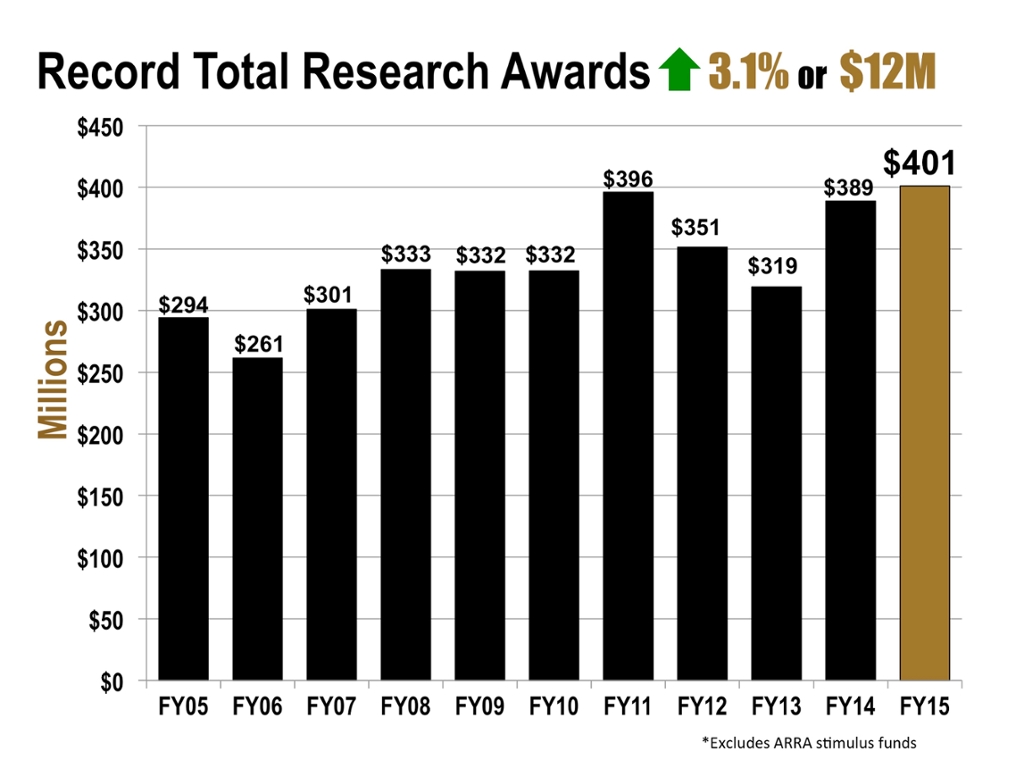 Secondly, the increasing tightness of federal budgets, and a scattering of marginal or even seemingly bizarre grant-funded publications, gives rise to occasional debates over what kinds of research deserve priority in the use of taxpayer dollars (or more accurately, additional borrowed dollars). The reflexive response of the academic community that all “research” of all kinds by anyone, anywhere is worthy of public subsidy, that neither citizens nor their elected representatives have any right to question any of it, is of dubious merit as either fiscal or general public policy. Pressing such an argument too hard risks discrediting the critically important program of basic scientific research on which so much of our economic progress and overall national success depends.
Secondly, the increasing tightness of federal budgets, and a scattering of marginal or even seemingly bizarre grant-funded publications, gives rise to occasional debates over what kinds of research deserve priority in the use of taxpayer dollars (or more accurately, additional borrowed dollars). The reflexive response of the academic community that all “research” of all kinds by anyone, anywhere is worthy of public subsidy, that neither citizens nor their elected representatives have any right to question any of it, is of dubious merit as either fiscal or general public policy. Pressing such an argument too hard risks discrediting the critically important program of basic scientific research on which so much of our economic progress and overall national success depends.
Meanwhile, I was gratified to be appointed to a new national commission on the future of undergraduate education, assembled by the American Academy of Arts and Sciences. At its first meeting, I listened to a strong and recurrent theme that too many universities are shortchanging teaching in favor of research. Stories were told of “teachers of the year” being denied tenure, or even told that a reputation for great teaching was a “kiss of death.”
Lastly, louder and more numerous voices are challenging the entire premise of university-based R&D as we have known it since the Vannevar Bush report at the close of World War II. A widely discussed book (What Technology Wants, by Kevin Kelly) argues, in one reviewer’s summation, that “Most technological breakthroughs come from technologists tinkering, not from researchers chasing hypotheses. Heretical as it may sound, ‘basic science’ isn’t nearly as productive of new inventions as we tend to think.”
I believe that Purdue research, in its nature, quality, and balance with our teaching mission, answers these criticisms. Preserving and extending our standards on all these grounds will produce even greater reputation and greater funding levels in 2016 and beyond.
STUDENT SUCCESS AT PURDUE
Across the country, colleges now testify to their commitment to “student success.” Media and public attention to deplorable progress and graduation rates have produced rather suddenly a plethora of interest groups, foundation grant programs, and public performance funding formulae, all aimed at delivering better “college completion” results.
It wasn’t always so. One higher ed officer of my acquaintance can recall meetings at the private college she once served devoted to “getting the fifth year numbers up.” In case the deplorable meaning isn’t clear, that meant how to maneuver more students into a fifth year at school and the extra tuition that would accompany it.
Purdue never took so crass an attitude, but until recently we allowed a variety of internal obstacles, such as unjustifiable refusals by some of our colleges to recognize credits earned at another, to force students to spend extra time and money en route to their degree. And it does seem every Boilermaker alum I meet can remember a “Look around. You won’t all be here” speech from one or more first-year classes.
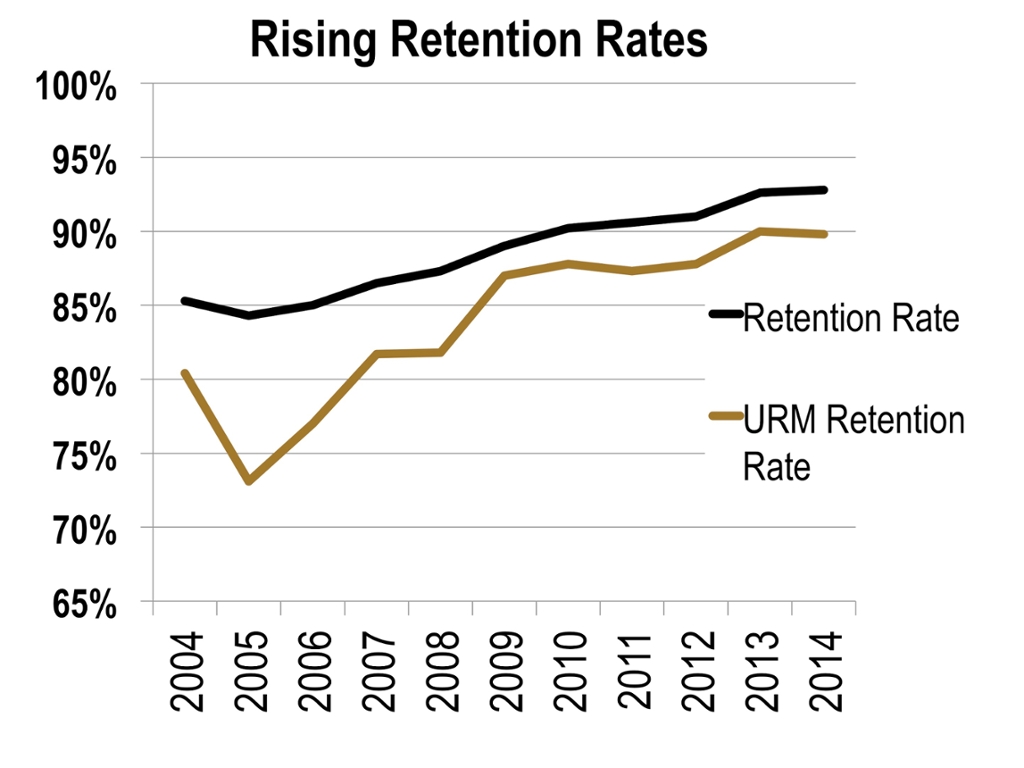
These days, happily, a new consensus has emerged that our goal is not to “weed ’em out” but to “help ’em out”, all the way through to an on-time graduation. All our own retention and progress rates are rising swiftly: in the last five years, first-year retention, now 93%, is up 3 percentage points, having surpassed the Big Ten mean in the process. Over the same time frame, second-year retention is up more than 5 percentage points. First-year retention of underrepresented minorities is up 10 points over the last decade.
If we are honest, we must acknowledge that much of this progress has come not from the university’s efforts but simply from the stronger academic readiness of the students we enroll. As I announced in last year’s letter, we would open our doors to a substantially larger freshman class, and we exceeded our 6800-student target, for a growth of about 7%. The number of Indiana freshmen was the highest in many years. Interest and demand for a Purdue education is so strong that the academic profile of that larger class rose, anyway. That alone augurs well for continued improvement in success measures. But we must do better than just to ride a tide of more talented and college-ready entrants.
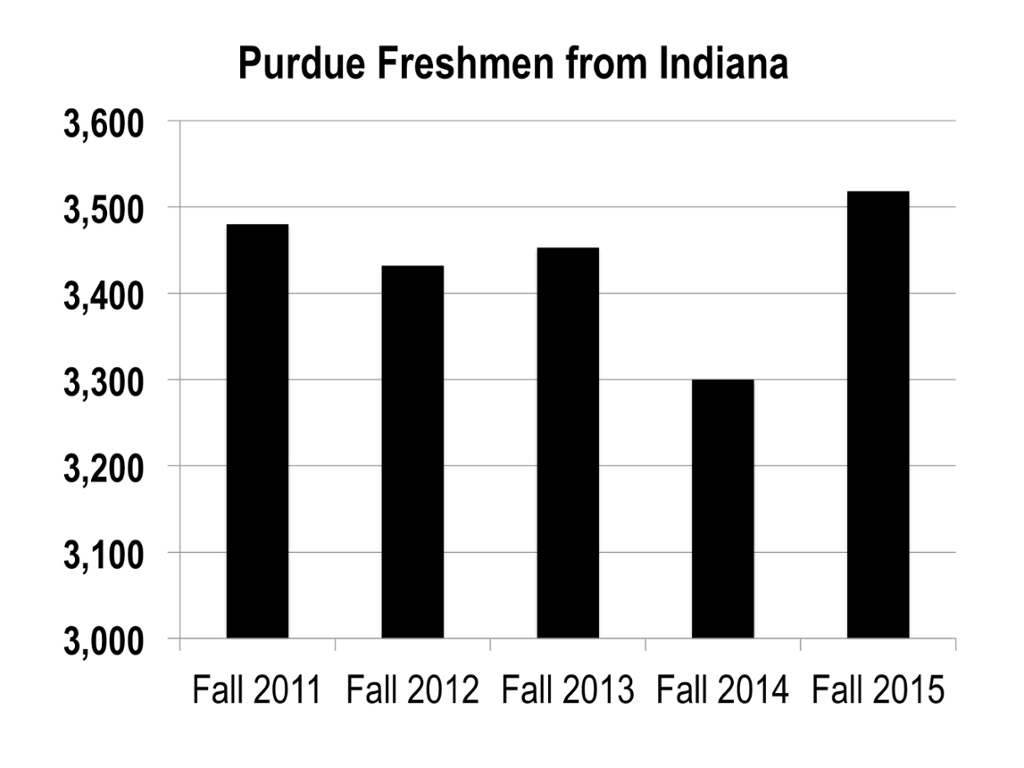 If turning away less prepared applicants is one easy route to higher graduation rates, another is to relax rigor and dispense diplomas to young people who really haven’t learned much. Such laxity, of course, has become widespread in American higher ed, as countless books and studies have documented. I believe we can assert confidently that Purdue has resisted this temptation. Yes, with more than 4000 courses on offer, we have a number that one could not in good conscience recommend are worth a student’s time or a parent’s tuition. But compared to what appears to go on at many schools, ours is still a place characterized by a meaningful, substantive curriculum.
If turning away less prepared applicants is one easy route to higher graduation rates, another is to relax rigor and dispense diplomas to young people who really haven’t learned much. Such laxity, of course, has become widespread in American higher ed, as countless books and studies have documented. I believe we can assert confidently that Purdue has resisted this temptation. Yes, with more than 4000 courses on offer, we have a number that one could not in good conscience recommend are worth a student’s time or a parent’s tuition. But compared to what appears to go on at many schools, ours is still a place characterized by a meaningful, substantive curriculum.
Moreover, our Purdue faculty have maintained, anecdotally and statistically, tougher standards of performance and evaluation than the current norm across American higher ed. The average student GPA is a relatively low 2.96, and the number of students forced or choosing to repeat a course would probably surprise a newcomer (it sure surprised me).
Purdue is one of 11 schools which have organized the University Innovation Alliance, a group committed to successfully educating larger numbers of first-generation, low-income, and minority students, by devising and sharing with each other new technologies and techniques for doing so. The Alliance received the largest grant to date from the Obama administration’s “First in the World” initiative. Early projects involve the use of data analytics to spot students likely to run into academic difficulty, and the refining of innovative “active learning” practices, the category in which Purdue has the lead assignment. Alliance members have accepted the duty to recruit, educate, and graduate students from all backgrounds; Purdue is proud to be a part of this noble venture.
Again this year we will aim to increase the number of incoming freshmen, this time to a base of at least 6,850. And this summer we inaugurate Summer Start, a credit-bearing program aimed at bringing an additional 150 or more students to campus for a head start on a successful college career. There are risks around both goals, but the payoff will more than justify taking them.
So, yes, student success the Purdue way is a purposely harder task than it has to be. We are committed to our land-grant mission, and will enroll larger numbers of students even if academic profile flattens as a consequence. We will employ all techniques, new and time-tested, to identify students who may struggle, and tutor, mentor, and otherwise assist them all we can. We will achieve steadily higher rates of progress and graduation without relaxing the rigor for which Purdue is justly renowned.
ATHLETICS AT PURDUE
Few activities can infuse life into a campus as much as our intercollegiate sports teams do. No, sports is not the core purpose of a university like ours and yes, the size and emphasis on college athletics is a uniquely American custom, not seen anywhere else in the world or even in the U.S. until the last century or so. But its role in bringing students together with each other, and with alumni and members of our neighboring communities, cannot be denied.
Nor can the growing abuses and excesses that should trouble even those who, like me, are avid lifelong sports fans. Providing the enjoyment and excitement that athletic competition creates without surrendering to the collapsed standards that the unconstrained pursuit of victory often produces, is a challenge of increasing difficulty, especially in the top-tier division in which Purdue participates.
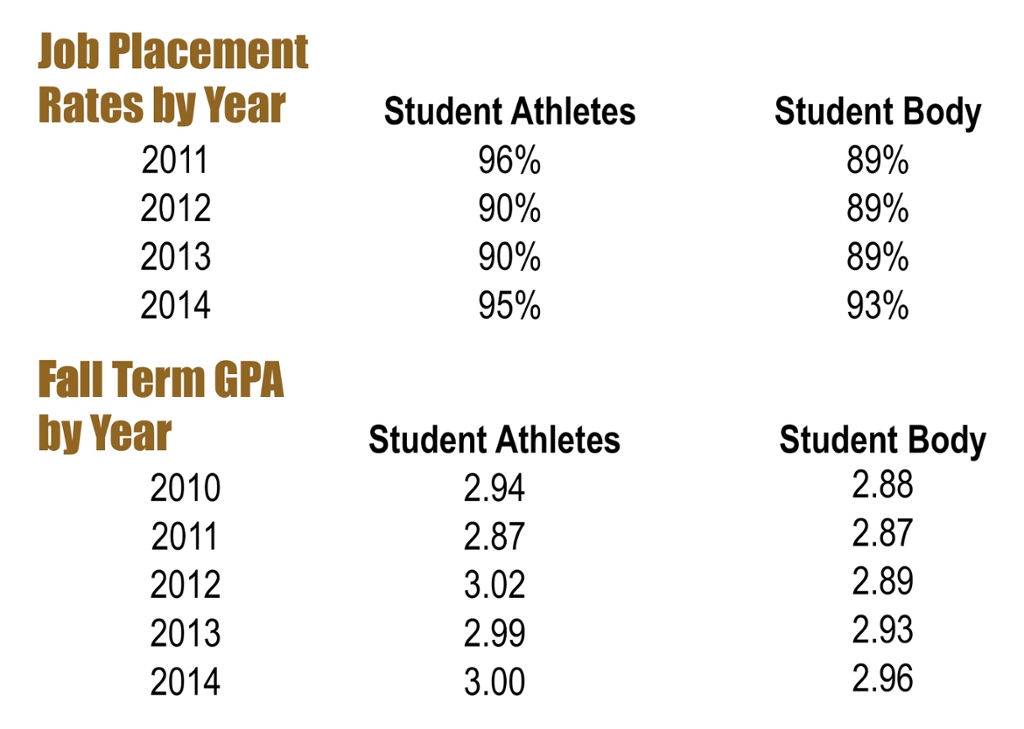 2015, like all recent years, saw a rash of scandals, both behavioral and financial. There were more incidents of schools recruiting or transferring in players with histories of violence against women or other unacceptable misconduct. One high-profile Division I coach was quoted as saying, “We were doing fine until classes started.” Peer institutions, while heavily subsidizing athletics from student tuition and fees, still run deficits forcing the cancellation of “non-revenue” sports. Coaching salaries and total budgets continue to escalate. With tongue only partially in cheek, one college president I know of quips, “We hope to be a university our football team can be proud of.”
2015, like all recent years, saw a rash of scandals, both behavioral and financial. There were more incidents of schools recruiting or transferring in players with histories of violence against women or other unacceptable misconduct. One high-profile Division I coach was quoted as saying, “We were doing fine until classes started.” Peer institutions, while heavily subsidizing athletics from student tuition and fees, still run deficits forcing the cancellation of “non-revenue” sports. Coaching salaries and total budgets continue to escalate. With tongue only partially in cheek, one college president I know of quips, “We hope to be a university our football team can be proud of.”
Against this discouraging backdrop, Purdue continues to hold itself to standards of which our Boilermaker family can be proud. Athlete conduct has been generally exemplary, and when transgressions have occurred, they have been dealt with promptly and firmly. “Student athlete” is an oxymoron at some colleges, but not ours: Purdue is home to real students, taking real courses, getting honest grades. Again in 2015, as it has for almost three decades, the all-athlete GPA exceeded that of the student body as a whole.
And our athletic department remained one of the few in America that pays for itself. As it stands, fewer than 2% of our undergraduates participate in an intercollegiate sport. We can be glad that the other 98% are not involuntarily charged to subsidize an activity beyond their abilities and perhaps outside their areas of interest.
It is highly likely that the next few years will bring us markedly increased athletic revenues, regardless of the winning percentage of our men’s football and basketball teams. Our Big Ten Conference, led by the extraordinarily skillful commissioner who created the Big Ten Network, is in the process of renewing the conference’s national television contracts at much higher rights fees.
If successful, this would represent a fundamental acceleration of an already apparent trend. Not long ago, the vast majority of Big Ten athletic department revenues came from ticket sales and related receipts; soon, the commissioner reports, a majority will derive from media payments. So the impending major increase is a big moment. But not necessarily a purely positive one because, if every penny of this new revenue is poured into athletics, it will simply fuel the next round of an arms race that is already out of control.
On one hand, the new infusion will enable many schools to end their subsidies and onerous student fees and retain general revenues for academic purposes. And, within limits, it will enable our university to compete more evenly with schools who assign athletics an even higher priority than we might think appropriate.
If the new contracts eventuate as expected, I will speak in favor of a conference-wide approach that commits a meaningful share of incremental media dollars to the academic missions of our universities. There is great opportunity here, for Purdue and the other Big Ten members, and maybe also to make a statement of value to the rest of American higher ed and to our fellow devotees of excellence in college sports.
ONE PURDUE
The 2015 annual meeting of the Association of Public and Land-Grant Universities happened to meet in Indianapolis, and happened to convene on the weekend that some 200 Purdue students rallied to show support for student advocacy occurring at the University of Missouri and elsewhere. At APLU, virtually every president in attendance had just come from the site of similar activities.
Not for the first time, the Purdue rally featured expressions of concern about the experiences of minority students on our campus, and about various university efforts to improve those experiences. Purdue takes these concerns very seriously, and acts on them in all ways we deem likely to be effective, consistent with universal legal and constitutional rights, and fair to all. A majority of the proposals made by the rally organizers, such as the recruitment of more minority students and faculty, and the raising of more funds for scholarships and financial assistance, are aligned with these criteria, and we will act on them or, in most cases, redouble the major efforts already underway to achieve them.
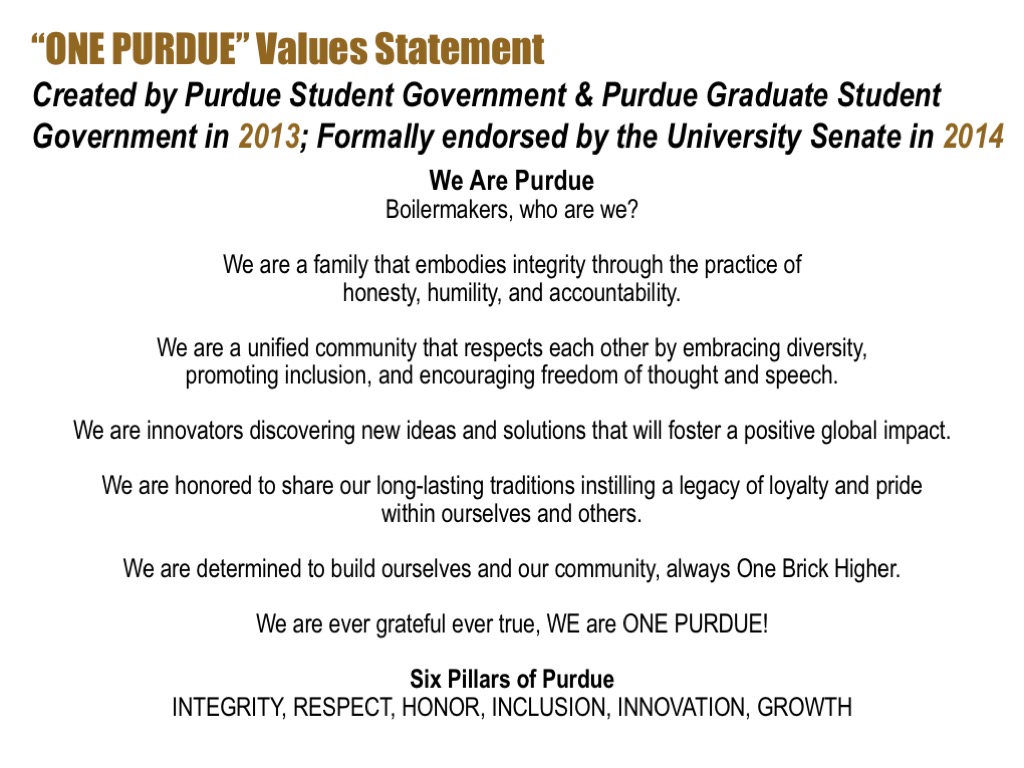 As we do so, a couple of simple and obvious observations are in order. First, an ethos of inclusion and anti-discrimination is perhaps the strongest and most ubiquitous value on our enormous and enormously diverse campus. People who disagree about other things are united in their commitment to a climate that is, in a slogan I admire from a fellow APLU school “Welcoming to all and hostile to none.” As I told students at one of the post-rally conversations we have held, there would be no swifter or surer way to be condemned and ostracized at Purdue than to say or do anything even remotely racist, and the condemnation would start with me.
As we do so, a couple of simple and obvious observations are in order. First, an ethos of inclusion and anti-discrimination is perhaps the strongest and most ubiquitous value on our enormous and enormously diverse campus. People who disagree about other things are united in their commitment to a climate that is, in a slogan I admire from a fellow APLU school “Welcoming to all and hostile to none.” As I told students at one of the post-rally conversations we have held, there would be no swifter or surer way to be condemned and ostracized at Purdue than to say or do anything even remotely racist, and the condemnation would start with me.
Second, one would search without avail for a place more totally committed to the success of its low-income, first-generation, and minority students than today’s Purdue. We spend millions of dollars and, as detailed above, are in some respects a national leader in this endeavor. The concerned students we heard from recently are typical in talent, motivation, and leadership potential of their 40,000 colleagues. We expect great things from them as graduates, and the university is organized as never before to help them launch those lives of leadership. On these two ideals, we are, as close as any community our size can possibly be, truly One Purdue.
Here’s wishing everyone a 2016 of learning, discovery, and shared purpose.
Hail Purdue!
Mitchell E. Daniels, Jr.
President